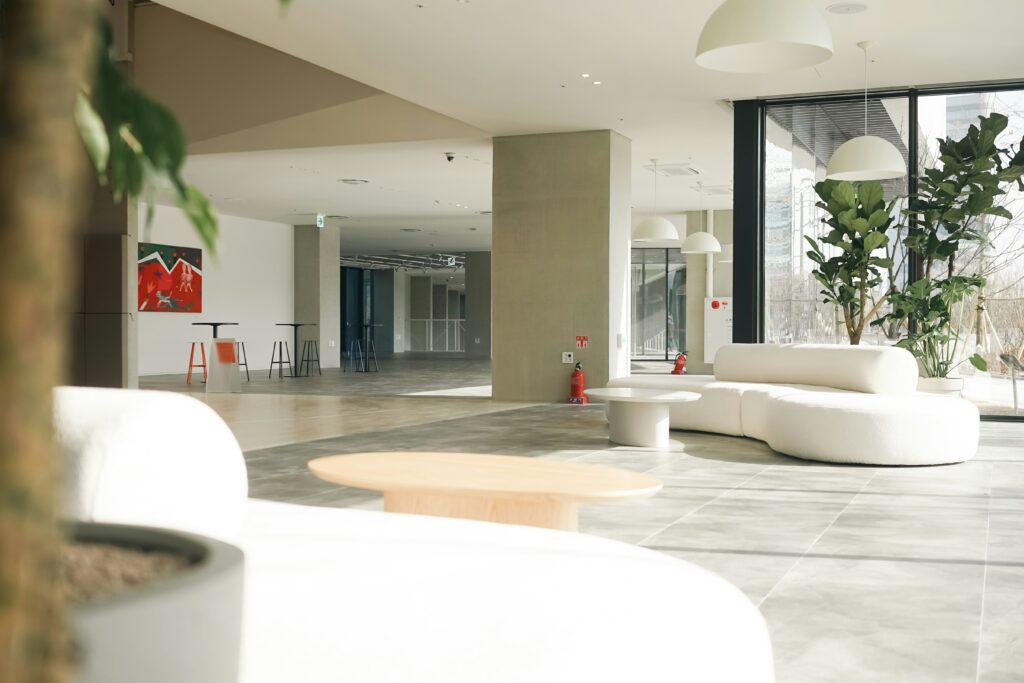By Mercedes Quintanilla.
In today’s context, biophilic design has established itself as an essential standard for 21st-century workplaces. Its integration not only promotes occupant well-being but also has a tangible positive impact on financial outcomes. Environments that embrace nature enhance productivity, reduce absenteeism, and, in turn, optimize operational costs.
Numerous studies support the tangible benefits biophilia offers in the workplace. It has been shown that incorporating natural elements into built environments can increase employee’s sense of well-being by up to 40%, while also boosting creativity, focus, and overall performance.

Key Benefits of Biophilic Design in the Workplace
- Access to natural light and outdoor views According to a Human Spaces report for the EMEA region (Europe, the Middle East, and Africa), a staggering 30% of office workers have no direct access to natural light. This factor directly impacts health and productivity, making natural light not just a matter of comfort, but also of performance and well-being.
- Maximizing outdoor areas A connection to the outdoors—whether through green spaces, gardens, or terraces—not only beautifies the environment but also provides a mental refuge, helping to reduce stress and stimulate creativity.
- Strategic use of color According to Bill Browning’s Savannah Hypothesis, certain colors—such as greens, blues, and earth tones—are deeply rooted in our evolutionary psychology. These colors evoke natural resources that support survival, generating positive emotional responses. On the other hand, red can enhance performance in tasks that require cognitive focus, while greens and blues stimulate creativity and innovation.
- Incorporating vegetation The presence of plants in the workplace not only enriches the space visually but also increases oxygen levels, improving concentration and reducing mental fatigue. Plants contribute to a healthier and more balanced environment, translating into more focused and satisfied employees.
- Natural materials in interior design The integration of materials such as wood and stone not only adds sophisticated textures to the space but also creates a tangible connection to nature. These organic materials bring warmth and harmony, merging the best of both worlds—the outdoors with the indoors.

As nature is intentionally brought into the workplace, we witness a transformation not only in the design itself but also in the social and professional dynamics of those who inhabit these spaces. A workspace that embraces these principles is not just seen as a physical place, but as a sanctuary that fosters creativity, well-being, and productivity.
Key Principles for Integrating Biophilic Design into the Workplace
In the most ambitious projects, workplaces feature expansive green areas. However, even in smaller or more modest settings, biophilic principles can be effectively and accessibly incorporated. Below, we present some simple yet powerful strategies to create a more natural and enriching work environment:
- Maximizing natural light.
- Incorporating natural elements such as plants, wood, or stone.
- Using colors that evoke nature, such as greens, blues, and earth tones.
- Designing spaces that connect with the outdoors.
Implementing these strategies can transform any office into a sanctuary that nurtures well-being, productivity, and business success.
References.
✓ Freeman, K. (2019, October 15). Enriching the Workplace with Biophilic Design. Work Design Magazine. https://www.workdesign.com/2018/09/enriching-the-workplace-with-biophilic-design/
✓ Biophilic Office Design – Bringing Nature Into The Workplace | K2 Space. (2020b, October 29). K2space. https://k2space.co.uk/knowledge/biophilic-office-design/
✓ Kellert, S. and Calabrese, E. 2015. The Practice of Biophilic Design. www.biophilic-design.com
Read the Comments +